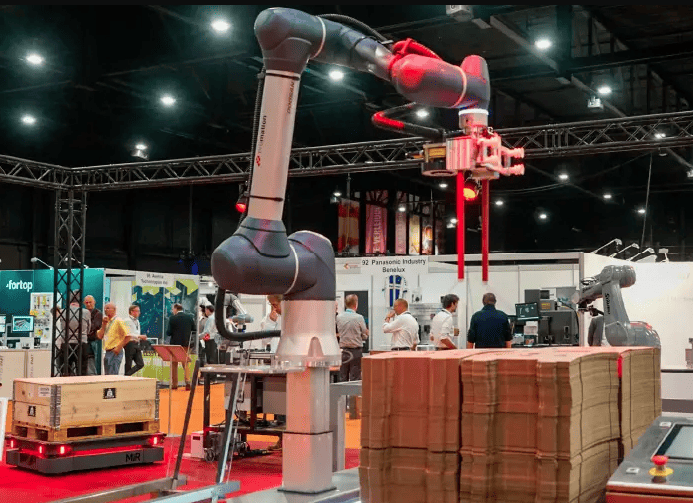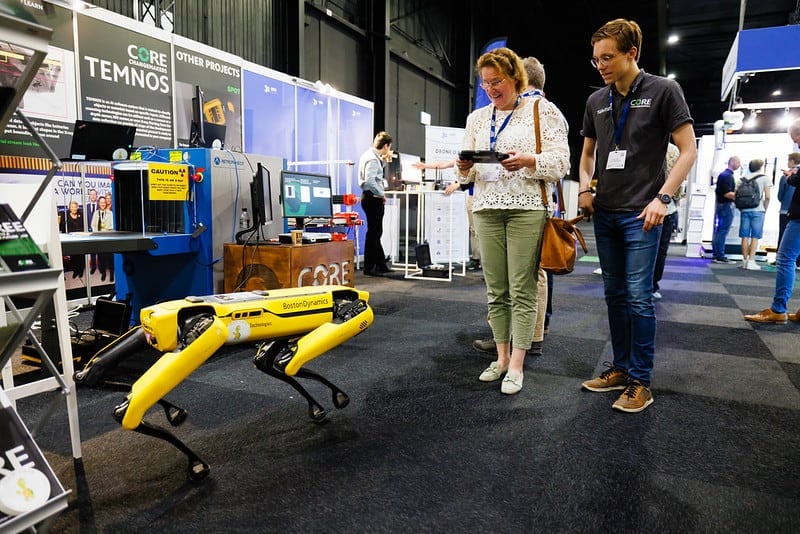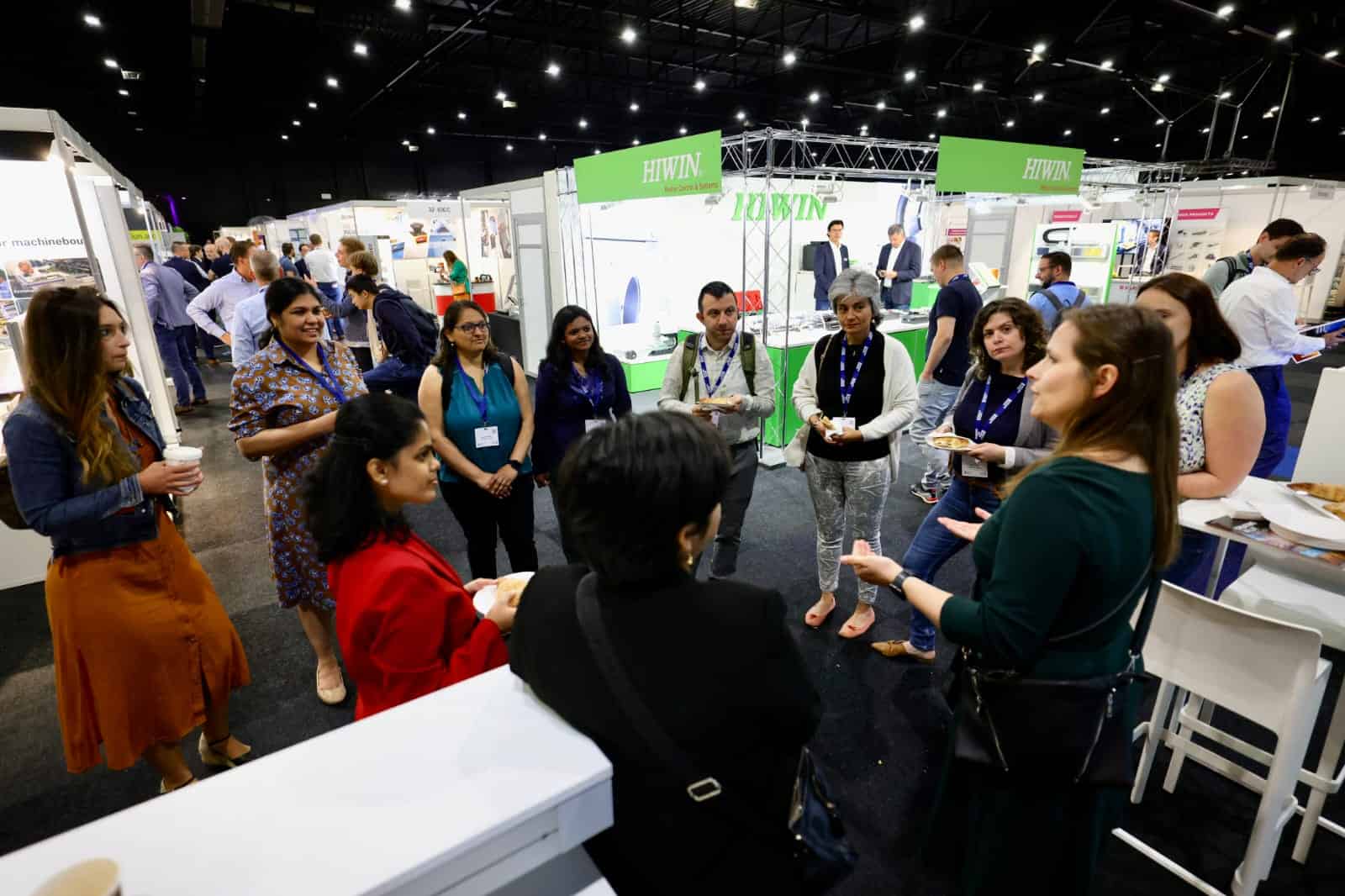
In the world of Industry 4.0, all kinds of production processes are interconnected. The maintenance department receives a signal that a part needs to be replaced, even before it breaks down. The various machines in a production process are finely tuned to each other to maximize capacity. And at the push of a button, management can call up all the necessary figures in real-time. That is Industry 4.0. Not a factory of the future but a rock-solid reality. Because it is all already available. Still, this doesn’t mean every Dutch factory hall has already implemented it in its systems. The trade fair Vision, Robotics & Motion to be held on June 7 and 8, 2023, in the Brabanthallen in ‘s Hertogenbosch will change that. Eddie Mennen of Yaskawa Benelux and Henk Oosterhuis of SICK tell more about it.
For 20 years, Vision, Robotics & Motion has been the trade fair where visitors find smart solutions for automation in the manufacturing industry. At this two-day fair, national and international experts and specialists in the field of Industry 4.0 are present. There they present techniques that give industry robots “sight”, so they can see that a package is skewed when palletizing. There are systems with which complete logistics processes can be finished without human intervention, such as picking robots in automated greenhouses. And systems through which the software of different machines can exchange data with each other for the optimal utilization of production capacity.
Industry 4.0 is a necessity in the eyes of various exhibitors. Because it could, for example, solve the labor shortage that is becoming increasingly evident. Yet as was the case with every previous industrial revolution, there is a reluctance to implement these solutions.
Struggle
One of the exhibitors at Vision, Robotics, and Motion is Japan’s Yaskawa Electric, one of the world market leaders in drives, industrial automation, and robotics. For example, production systems can become more intelligent, and machines can be linked together through interfaces. But controls can also become much more intuitive, allowing the operator to concentrate on other things.
“I think there is a lot of interest and willingness to get started with these new technologies,” says Managing Director Eddie Mennen of Yaskawa Benelux. “But there are a lot of people wondering: how then? When I listen to the market, I see a lot struggling to develop a good plan of action to implement it in their business. Most have the vistas in mind, but what they can concretely do with it tomorrow or the day after is not always clear. Surely, in terms of what we call i3 mechatronics, you must develop a good policy first. That is quite difficult for many people.”
According to Mennen, Dutch companies are quite good at getting started with innovative technologies. In his opinion, the Netherlands is not doing too badly than other European countries. The Netherlands is considered a country of early adopters. A testing ground where entrepreneurs are quite willing to test new developments in practice.
Up-to-date
However, Mennen sees a certain reluctance among entrepreneurs to actually set up such projects in practice. “That’s not much different in other countries, mind you. We are certainly not lagging behind. Our level of knowledge is quite up-to-date internationally. But implementing it all properly and bringing it to success is another story. There is a fear of investing in the wrong development, finding out after only a few years that you must disinvest again.”
A major stumbling block, according to Mennen, is still a lack of knowledge at many companies. That makes it harder to make the right choices. “Many companies need knowledge that they can acquire neutrally. And not with a commercial party that benefits directly from selling you something. In terms of applications, the supply is meager in that regard.”
Connectivity
“We do have knowledge institutions like TNO. But when it comes to making it concrete and how you can get applications going in your own factory, they don’t know where to get that knowledge. That’s where a cluster like the Mikrocentrum and the High Tech Platform can play an important role. The best counter would be where an entrepreneur can put his question and where he can be helped to implement those new applications in the field of Industry 4.0. That doesn’t have to be free. There are also steps for knowledge institutions to take there as well.”
One of the big hurdles to overcome is connectivity. How do you get machines from different manufacturers to communicate with each other? And suppose you have just invested in a good machine, but it turns out that it is unsuitable for linking to another system? Can you perhaps retrofit devices?
However, Mennen says, some manufacturers still do not want to open up their software to third parties. In Germany, meanwhile, the VDMA is working hard on an open-source standard: OPC-UA. This should make it easier to link systems from different manufacturers.
Scary
Product manager ing. Henk Oosterhuis of the sensor manufacturer SICK also sees reservations and objections from manufacturers at home and abroad. According to him, linking production processes to the IT environment causes many headaches for companies.
“For example, companies are not eager to link their production environment to a Cloud, where things happen that they cannot quite fathom, but from which their machines are controlled. They find that scary. And they do have a point there. The impact is pretty big. So you see companies looking for solutions that only work on their own premises. Apart from Cloud-like environments. But this, in turn, causes opportunities to be lost.”
SICK’s sensors are the eyes of industrial processes. With them, a system can “see” that in a logistics line, there is a product left in a transport box. Different devices and machines must be linked together to make that happen.
Artificial Intelligence
“We make it possible,” Oosterhuis explains, “to use that data from the sensors on the one hand for machine control and semi-independently from that to use that data for the IT environment. We do that now with sensors working with a so-called IO link. That’s the trend right now. But we are also going to introduce a platform – SICK ConnectX, where we will make all kinds of integration possibilities between sensors and the IT environment even easier.”
According to Oosterhuis, artificial intelligence (AI) will play a big role in those connected production environments. “AI in sensors again makes new things possible. Just take component viewing. When it comes to parts made exactly to size, it’s easy for a system to compare them to an example in the computer. That way, you can pick out anomalous ones.”
“But just do that with natural products, like croissants or other foods. Such products are not well defined. However, you can make a difference with AI in terms of inspections, quality control, and location determination. That puts automatic operations within reach that a human could only do until now. Nice example: is the almond right on the filled cake? Try expressing that in a formula. With AI, you can automate that check. That solves the problem of producers who have already automated their production line but still rely on human resources for quality control.”
Thousands of examples
According to Oosterhuis, such a system works best if the systems are linked in a Cloud. After all, the AI sensor must have thousands of examples of how an almond can sit correctly on a filled cake. You can easily incorporate those examples into the Cloud. SICK offers both systems that work autonomously on site and AI sensors linked to a Cloud. “You see those kinds of models emerging now.
In his opinion, the VR&M trade show is precisely a place to discuss the pros and cons of those different applications in an informal setting. “Here you see that demanders and providers get to talk to each other. You can very easily put a problem on the table and ask an exhibitor what he offers to solve a specific problem in the field of vision, robotics, or motion. That’s another reason for us to participate in it. And it’s also fun. I always find it inspiring sessions.”
Oosterhuis remembers well how a precision parts manufacturer approached him last year at the fair. “He had those parts he was producing checked manually. He also lacked quality reporting on those parts he made. He wanted to know how to automate that. We suggested using the original product description to have our sensors check the individual product and record that with a photo in a report. That way, you know that all the parts that are then delivered meet those exact requirements. It gives you a leg to stand on if there are complaints afterward that the product was delivered damaged. With that sensor reporting, you can prove for every part that it was correct when it left the factory.”







